Taxation Law Assignment: Analysis of Taxable Income and Deductions
VerifiedAdded on 2020/03/02
|12
|1894
|41
Homework Assignment
AI Summary
This taxation law assignment provides detailed solutions to four key questions, covering various aspects of Australian taxation. Question 1 analyzes four different scenarios related to allowable deductions under section 8-1 of the Income Tax Assessment Act 1997 (ITAA 1997), addressing issues such as moving machinery costs, asset revaluation, legal expenses for winding up a company, and legal expenses for business functions. Question 2 focuses on claiming input tax credits for advertising expenses under the Goods and Services Tax Ruling (GSTR) Act 1999, specifically referencing GSTR 2006/3 and the case of Ronpibon Tin NL v. FC of T. Question 3 delves into the computation of a foreign tax offset for an individual, including the calculation of assessable income, tax payable, and tax credits for income sourced from different countries (Australia, the United States, and the United Kingdom). Question 4 focuses on the computation of net income from a partnership, detailing the calculation of assessable income, allowable deductions, and the resulting net income. The assignment includes relevant legislation, case references, and detailed calculations to support the solutions.
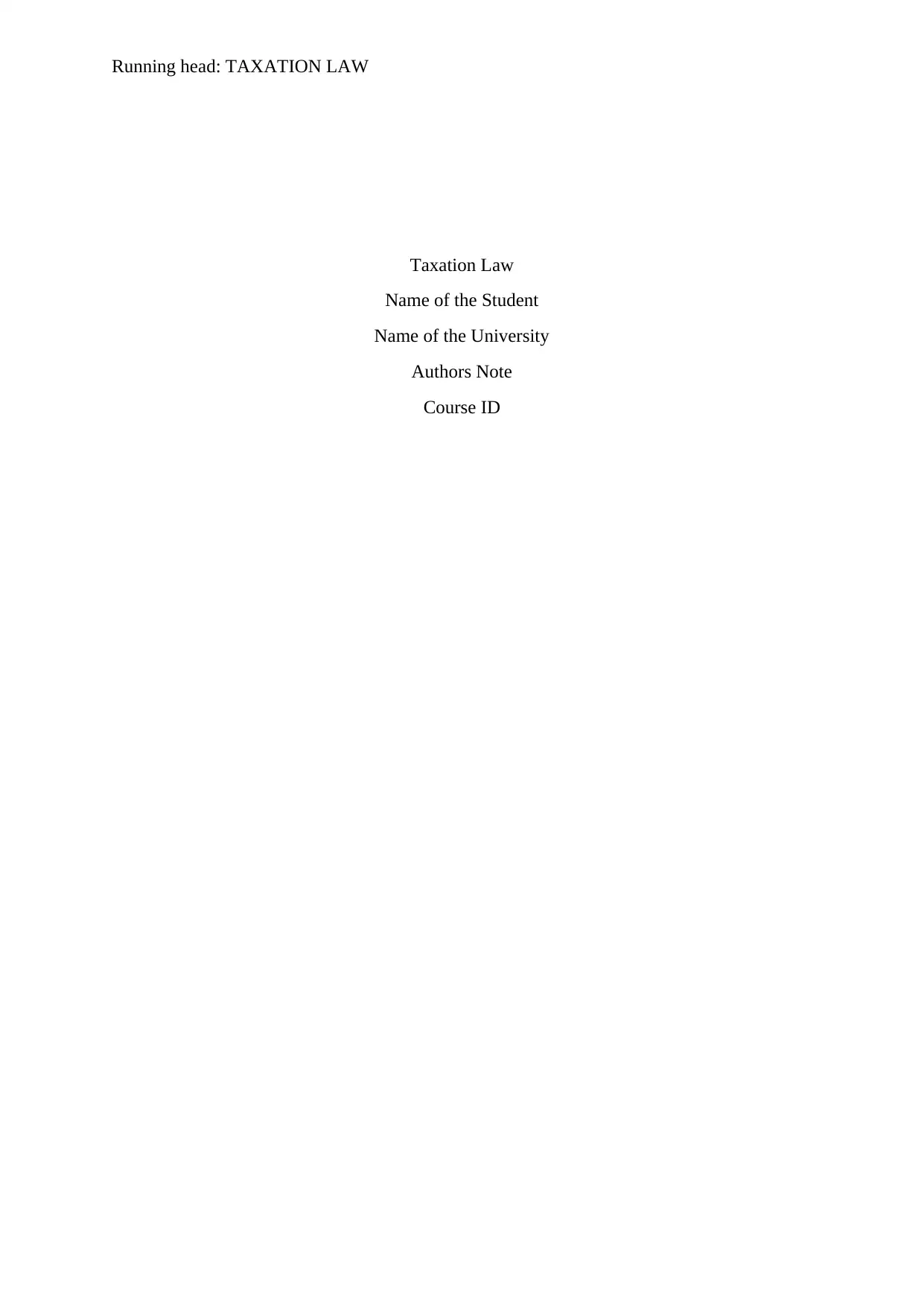
Running head: TAXATION LAW
Taxation Law
Name of the Student
Name of the University
Authors Note
Course ID
Taxation Law
Name of the Student
Name of the University
Authors Note
Course ID
Paraphrase This Document
Need a fresh take? Get an instant paraphrase of this document with our AI Paraphraser
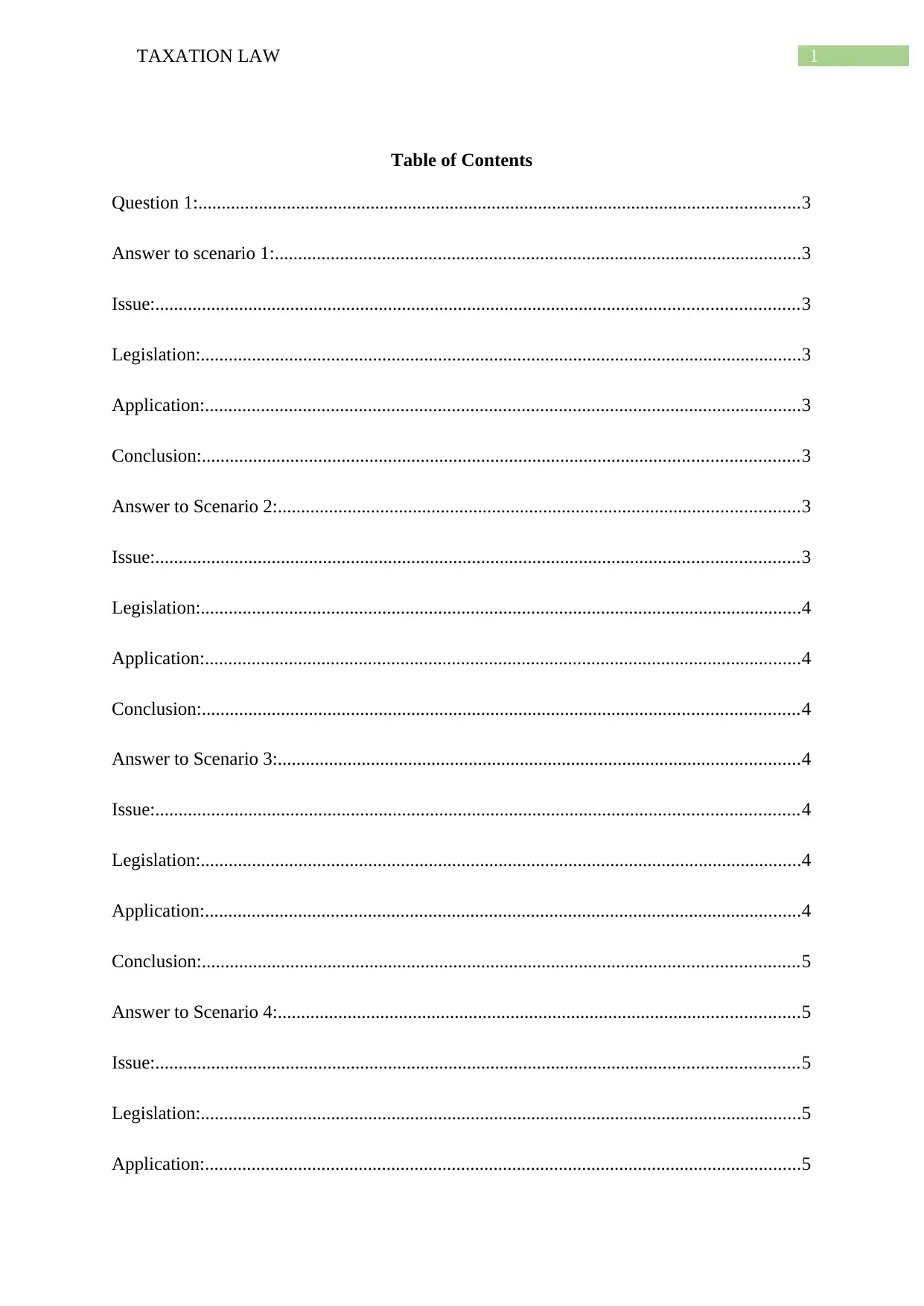
1TAXATION LAW
Table of Contents
Question 1:.................................................................................................................................3
Answer to scenario 1:.................................................................................................................3
Issue:..........................................................................................................................................3
Legislation:.................................................................................................................................3
Application:................................................................................................................................3
Conclusion:................................................................................................................................3
Answer to Scenario 2:................................................................................................................3
Issue:..........................................................................................................................................3
Legislation:.................................................................................................................................4
Application:................................................................................................................................4
Conclusion:................................................................................................................................4
Answer to Scenario 3:................................................................................................................4
Issue:..........................................................................................................................................4
Legislation:.................................................................................................................................4
Application:................................................................................................................................4
Conclusion:................................................................................................................................5
Answer to Scenario 4:................................................................................................................5
Issue:..........................................................................................................................................5
Legislation:.................................................................................................................................5
Application:................................................................................................................................5
Table of Contents
Question 1:.................................................................................................................................3
Answer to scenario 1:.................................................................................................................3
Issue:..........................................................................................................................................3
Legislation:.................................................................................................................................3
Application:................................................................................................................................3
Conclusion:................................................................................................................................3
Answer to Scenario 2:................................................................................................................3
Issue:..........................................................................................................................................3
Legislation:.................................................................................................................................4
Application:................................................................................................................................4
Conclusion:................................................................................................................................4
Answer to Scenario 3:................................................................................................................4
Issue:..........................................................................................................................................4
Legislation:.................................................................................................................................4
Application:................................................................................................................................4
Conclusion:................................................................................................................................5
Answer to Scenario 4:................................................................................................................5
Issue:..........................................................................................................................................5
Legislation:.................................................................................................................................5
Application:................................................................................................................................5
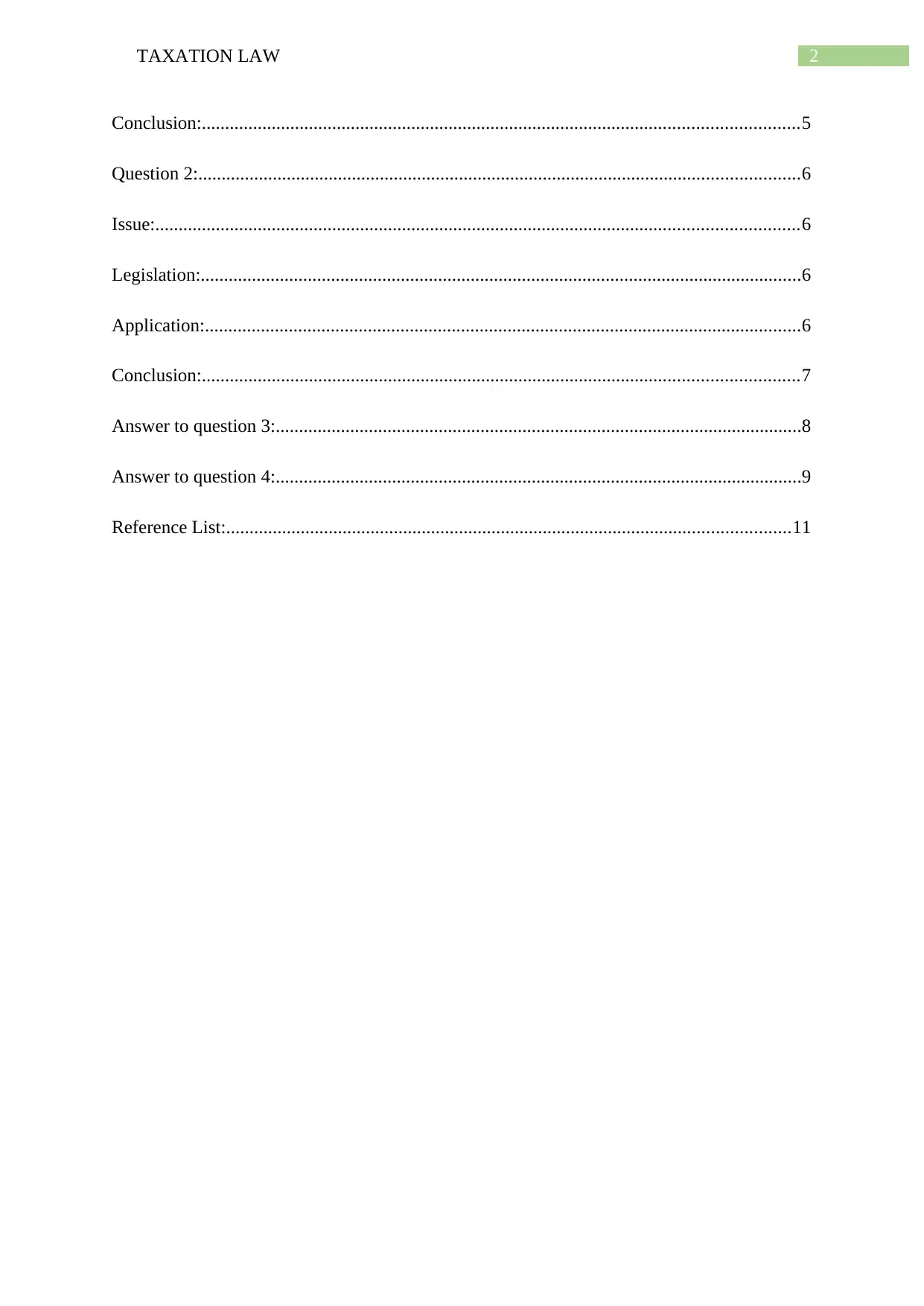
2TAXATION LAW
Conclusion:................................................................................................................................5
Question 2:.................................................................................................................................6
Issue:..........................................................................................................................................6
Legislation:.................................................................................................................................6
Application:................................................................................................................................6
Conclusion:................................................................................................................................7
Answer to question 3:.................................................................................................................8
Answer to question 4:.................................................................................................................9
Reference List:.........................................................................................................................11
Conclusion:................................................................................................................................5
Question 2:.................................................................................................................................6
Issue:..........................................................................................................................................6
Legislation:.................................................................................................................................6
Application:................................................................................................................................6
Conclusion:................................................................................................................................7
Answer to question 3:.................................................................................................................8
Answer to question 4:.................................................................................................................9
Reference List:.........................................................................................................................11
⊘ This is a preview!⊘
Do you want full access?
Subscribe today to unlock all pages.

Trusted by 1+ million students worldwide
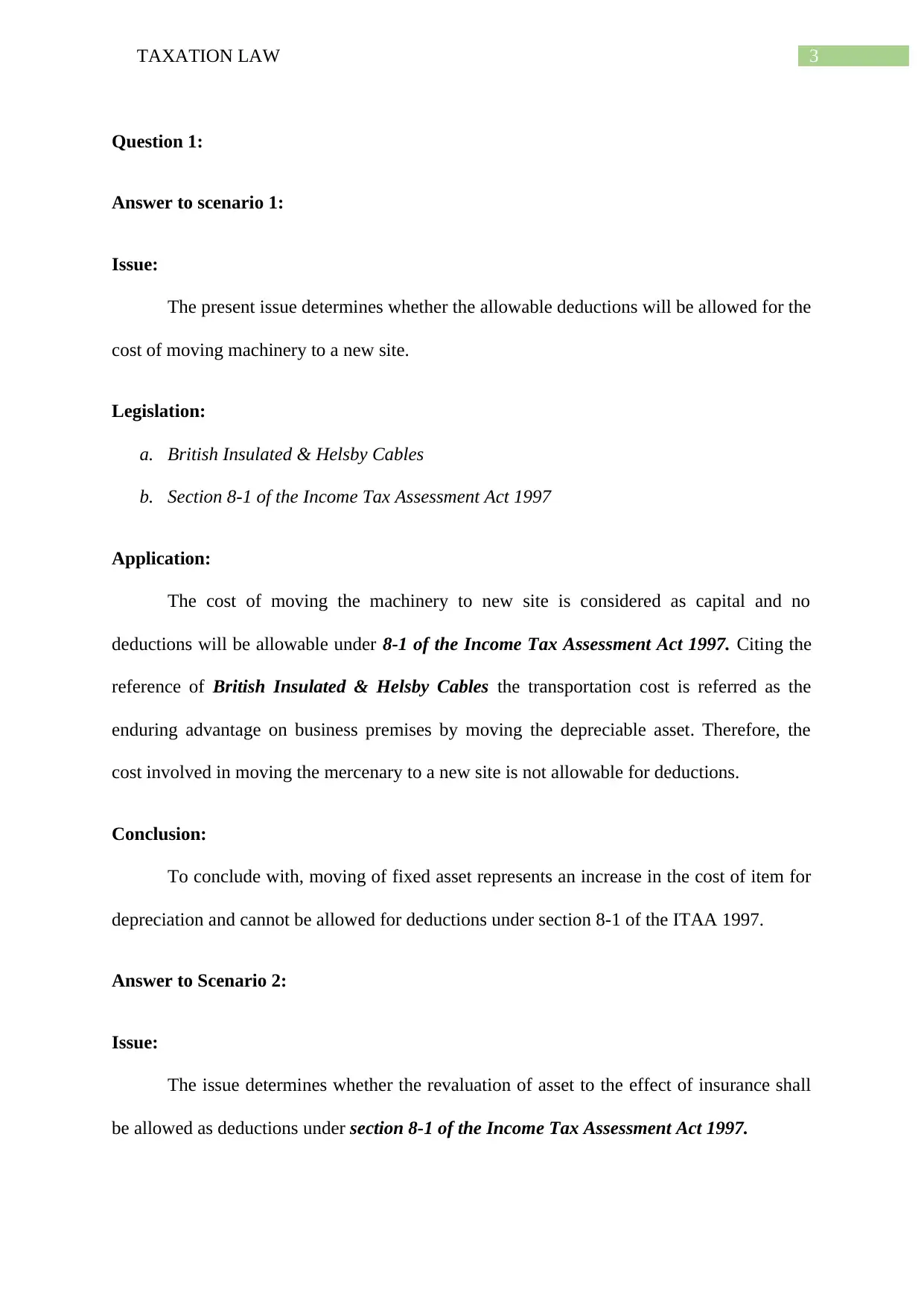
3TAXATION LAW
Question 1:
Answer to scenario 1:
Issue:
The present issue determines whether the allowable deductions will be allowed for the
cost of moving machinery to a new site.
Legislation:
a. British Insulated & Helsby Cables
b. Section 8-1 of the Income Tax Assessment Act 1997
Application:
The cost of moving the machinery to new site is considered as capital and no
deductions will be allowable under 8-1 of the Income Tax Assessment Act 1997. Citing the
reference of British Insulated & Helsby Cables the transportation cost is referred as the
enduring advantage on business premises by moving the depreciable asset. Therefore, the
cost involved in moving the mercenary to a new site is not allowable for deductions.
Conclusion:
To conclude with, moving of fixed asset represents an increase in the cost of item for
depreciation and cannot be allowed for deductions under section 8-1 of the ITAA 1997.
Answer to Scenario 2:
Issue:
The issue determines whether the revaluation of asset to the effect of insurance shall
be allowed as deductions under section 8-1 of the Income Tax Assessment Act 1997.
Question 1:
Answer to scenario 1:
Issue:
The present issue determines whether the allowable deductions will be allowed for the
cost of moving machinery to a new site.
Legislation:
a. British Insulated & Helsby Cables
b. Section 8-1 of the Income Tax Assessment Act 1997
Application:
The cost of moving the machinery to new site is considered as capital and no
deductions will be allowable under 8-1 of the Income Tax Assessment Act 1997. Citing the
reference of British Insulated & Helsby Cables the transportation cost is referred as the
enduring advantage on business premises by moving the depreciable asset. Therefore, the
cost involved in moving the mercenary to a new site is not allowable for deductions.
Conclusion:
To conclude with, moving of fixed asset represents an increase in the cost of item for
depreciation and cannot be allowed for deductions under section 8-1 of the ITAA 1997.
Answer to Scenario 2:
Issue:
The issue determines whether the revaluation of asset to the effect of insurance shall
be allowed as deductions under section 8-1 of the Income Tax Assessment Act 1997.
Paraphrase This Document
Need a fresh take? Get an instant paraphrase of this document with our AI Paraphraser
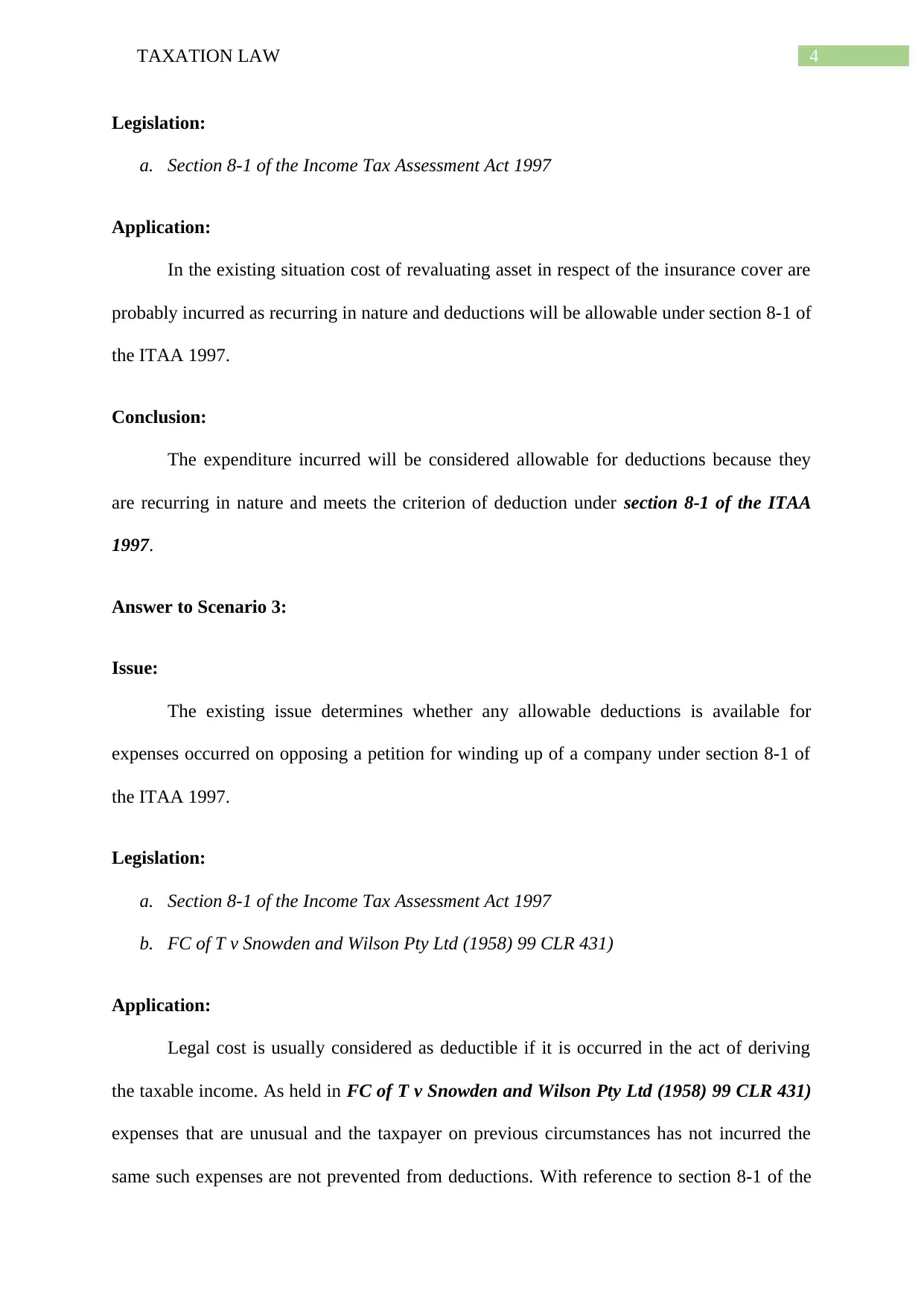
4TAXATION LAW
Legislation:
a. Section 8-1 of the Income Tax Assessment Act 1997
Application:
In the existing situation cost of revaluating asset in respect of the insurance cover are
probably incurred as recurring in nature and deductions will be allowable under section 8-1 of
the ITAA 1997.
Conclusion:
The expenditure incurred will be considered allowable for deductions because they
are recurring in nature and meets the criterion of deduction under section 8-1 of the ITAA
1997.
Answer to Scenario 3:
Issue:
The existing issue determines whether any allowable deductions is available for
expenses occurred on opposing a petition for winding up of a company under section 8-1 of
the ITAA 1997.
Legislation:
a. Section 8-1 of the Income Tax Assessment Act 1997
b. FC of T v Snowden and Wilson Pty Ltd (1958) 99 CLR 431)
Application:
Legal cost is usually considered as deductible if it is occurred in the act of deriving
the taxable income. As held in FC of T v Snowden and Wilson Pty Ltd (1958) 99 CLR 431)
expenses that are unusual and the taxpayer on previous circumstances has not incurred the
same such expenses are not prevented from deductions. With reference to section 8-1 of the
Legislation:
a. Section 8-1 of the Income Tax Assessment Act 1997
Application:
In the existing situation cost of revaluating asset in respect of the insurance cover are
probably incurred as recurring in nature and deductions will be allowable under section 8-1 of
the ITAA 1997.
Conclusion:
The expenditure incurred will be considered allowable for deductions because they
are recurring in nature and meets the criterion of deduction under section 8-1 of the ITAA
1997.
Answer to Scenario 3:
Issue:
The existing issue determines whether any allowable deductions is available for
expenses occurred on opposing a petition for winding up of a company under section 8-1 of
the ITAA 1997.
Legislation:
a. Section 8-1 of the Income Tax Assessment Act 1997
b. FC of T v Snowden and Wilson Pty Ltd (1958) 99 CLR 431)
Application:
Legal cost is usually considered as deductible if it is occurred in the act of deriving
the taxable income. As held in FC of T v Snowden and Wilson Pty Ltd (1958) 99 CLR 431)
expenses that are unusual and the taxpayer on previous circumstances has not incurred the
same such expenses are not prevented from deductions. With reference to section 8-1 of the
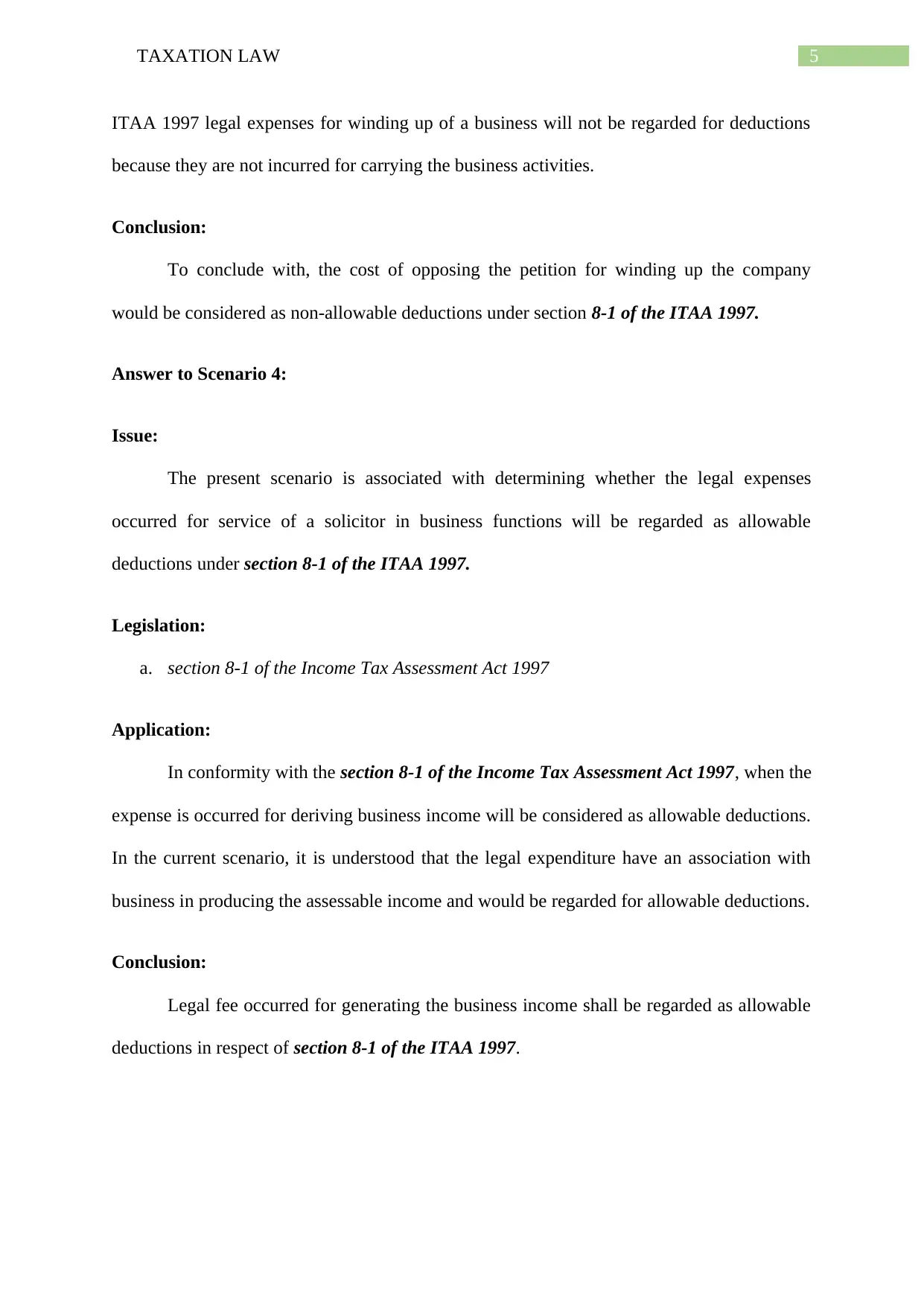
5TAXATION LAW
ITAA 1997 legal expenses for winding up of a business will not be regarded for deductions
because they are not incurred for carrying the business activities.
Conclusion:
To conclude with, the cost of opposing the petition for winding up the company
would be considered as non-allowable deductions under section 8-1 of the ITAA 1997.
Answer to Scenario 4:
Issue:
The present scenario is associated with determining whether the legal expenses
occurred for service of a solicitor in business functions will be regarded as allowable
deductions under section 8-1 of the ITAA 1997.
Legislation:
a. section 8-1 of the Income Tax Assessment Act 1997
Application:
In conformity with the section 8-1 of the Income Tax Assessment Act 1997, when the
expense is occurred for deriving business income will be considered as allowable deductions.
In the current scenario, it is understood that the legal expenditure have an association with
business in producing the assessable income and would be regarded for allowable deductions.
Conclusion:
Legal fee occurred for generating the business income shall be regarded as allowable
deductions in respect of section 8-1 of the ITAA 1997.
ITAA 1997 legal expenses for winding up of a business will not be regarded for deductions
because they are not incurred for carrying the business activities.
Conclusion:
To conclude with, the cost of opposing the petition for winding up the company
would be considered as non-allowable deductions under section 8-1 of the ITAA 1997.
Answer to Scenario 4:
Issue:
The present scenario is associated with determining whether the legal expenses
occurred for service of a solicitor in business functions will be regarded as allowable
deductions under section 8-1 of the ITAA 1997.
Legislation:
a. section 8-1 of the Income Tax Assessment Act 1997
Application:
In conformity with the section 8-1 of the Income Tax Assessment Act 1997, when the
expense is occurred for deriving business income will be considered as allowable deductions.
In the current scenario, it is understood that the legal expenditure have an association with
business in producing the assessable income and would be regarded for allowable deductions.
Conclusion:
Legal fee occurred for generating the business income shall be regarded as allowable
deductions in respect of section 8-1 of the ITAA 1997.
⊘ This is a preview!⊘
Do you want full access?
Subscribe today to unlock all pages.

Trusted by 1+ million students worldwide
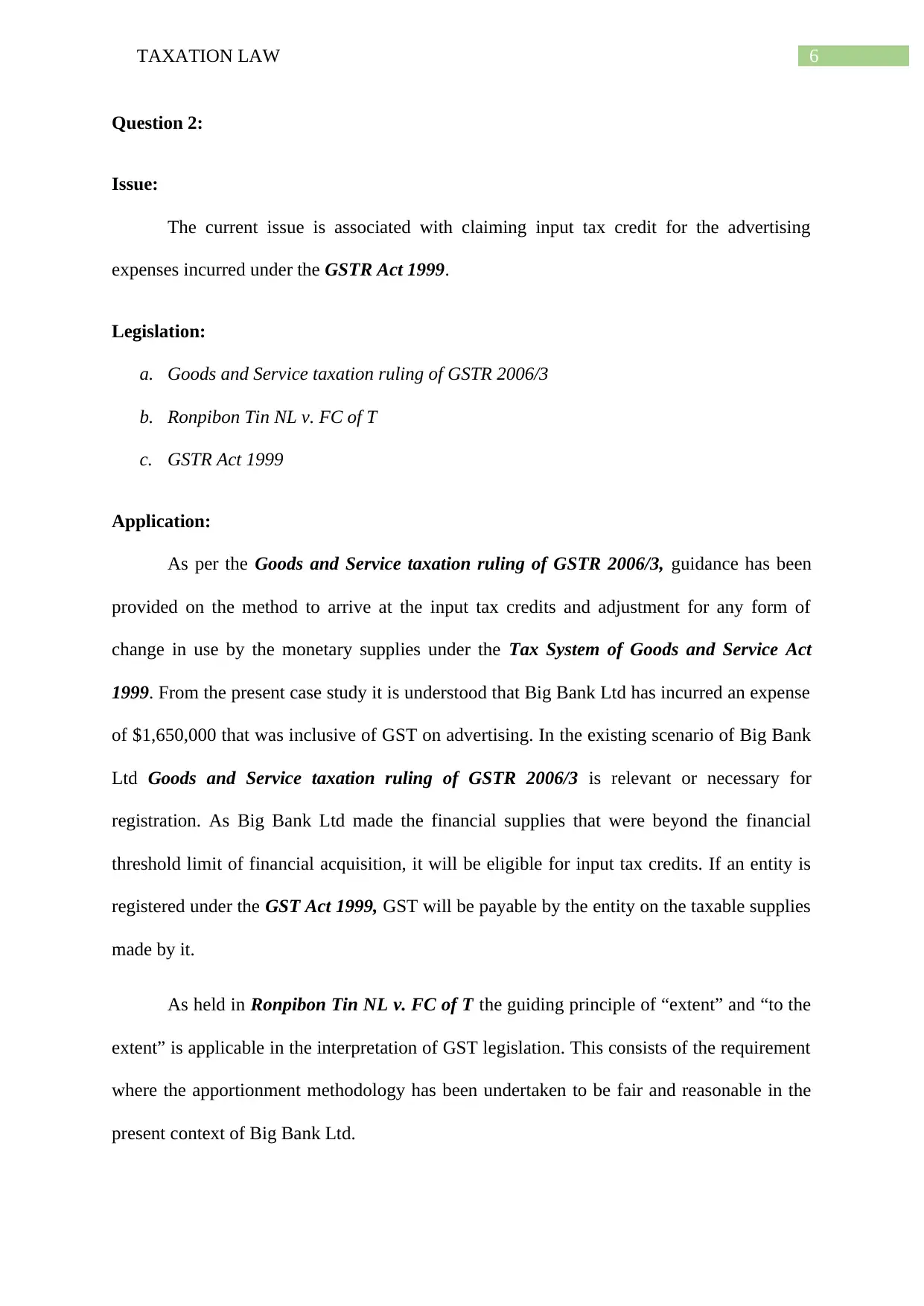
6TAXATION LAW
Question 2:
Issue:
The current issue is associated with claiming input tax credit for the advertising
expenses incurred under the GSTR Act 1999.
Legislation:
a. Goods and Service taxation ruling of GSTR 2006/3
b. Ronpibon Tin NL v. FC of T
c. GSTR Act 1999
Application:
As per the Goods and Service taxation ruling of GSTR 2006/3, guidance has been
provided on the method to arrive at the input tax credits and adjustment for any form of
change in use by the monetary supplies under the Tax System of Goods and Service Act
1999. From the present case study it is understood that Big Bank Ltd has incurred an expense
of $1,650,000 that was inclusive of GST on advertising. In the existing scenario of Big Bank
Ltd Goods and Service taxation ruling of GSTR 2006/3 is relevant or necessary for
registration. As Big Bank Ltd made the financial supplies that were beyond the financial
threshold limit of financial acquisition, it will be eligible for input tax credits. If an entity is
registered under the GST Act 1999, GST will be payable by the entity on the taxable supplies
made by it.
As held in Ronpibon Tin NL v. FC of T the guiding principle of “extent” and “to the
extent” is applicable in the interpretation of GST legislation. This consists of the requirement
where the apportionment methodology has been undertaken to be fair and reasonable in the
present context of Big Bank Ltd.
Question 2:
Issue:
The current issue is associated with claiming input tax credit for the advertising
expenses incurred under the GSTR Act 1999.
Legislation:
a. Goods and Service taxation ruling of GSTR 2006/3
b. Ronpibon Tin NL v. FC of T
c. GSTR Act 1999
Application:
As per the Goods and Service taxation ruling of GSTR 2006/3, guidance has been
provided on the method to arrive at the input tax credits and adjustment for any form of
change in use by the monetary supplies under the Tax System of Goods and Service Act
1999. From the present case study it is understood that Big Bank Ltd has incurred an expense
of $1,650,000 that was inclusive of GST on advertising. In the existing scenario of Big Bank
Ltd Goods and Service taxation ruling of GSTR 2006/3 is relevant or necessary for
registration. As Big Bank Ltd made the financial supplies that were beyond the financial
threshold limit of financial acquisition, it will be eligible for input tax credits. If an entity is
registered under the GST Act 1999, GST will be payable by the entity on the taxable supplies
made by it.
As held in Ronpibon Tin NL v. FC of T the guiding principle of “extent” and “to the
extent” is applicable in the interpretation of GST legislation. This consists of the requirement
where the apportionment methodology has been undertaken to be fair and reasonable in the
present context of Big Bank Ltd.
Paraphrase This Document
Need a fresh take? Get an instant paraphrase of this document with our AI Paraphraser
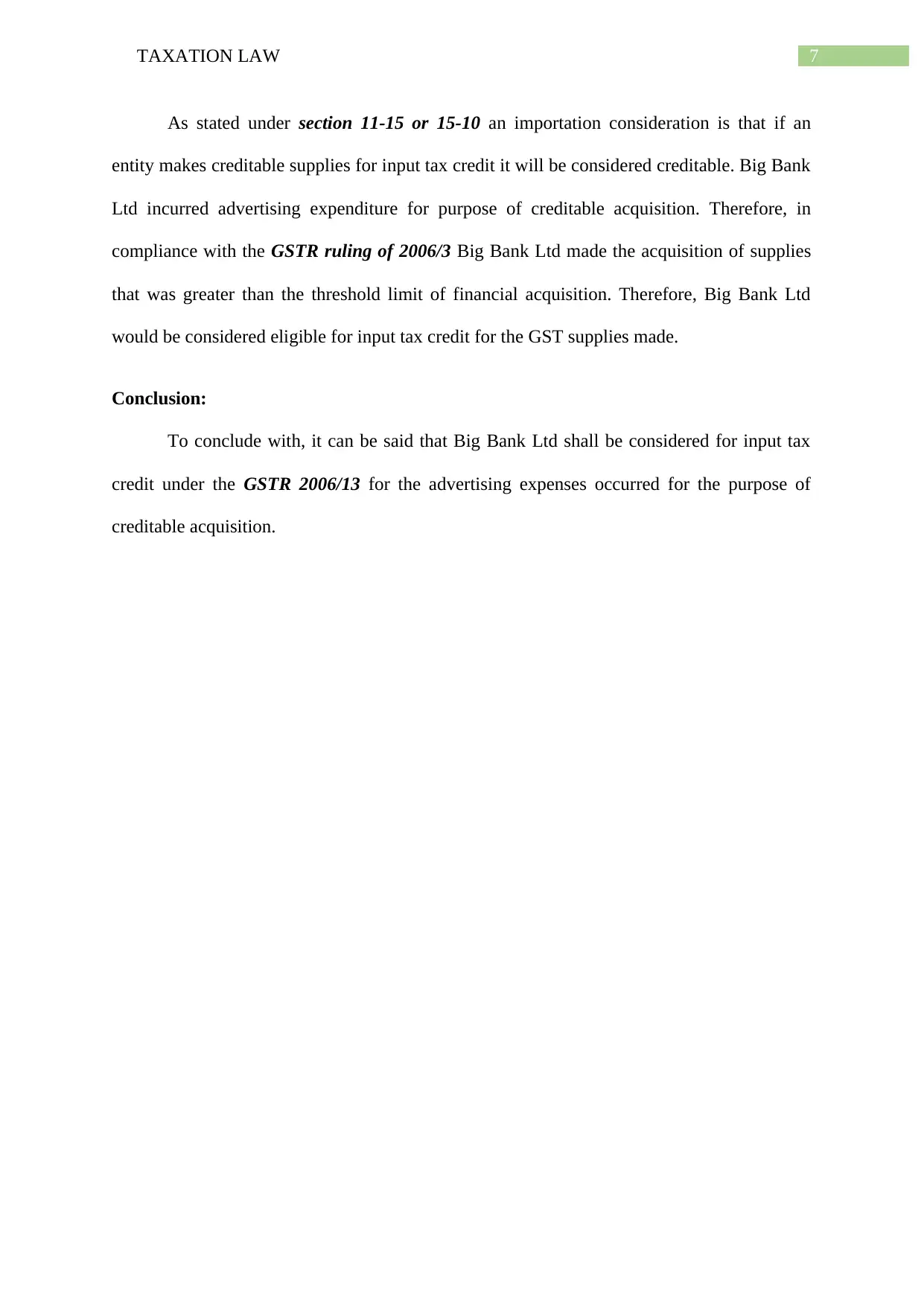
7TAXATION LAW
As stated under section 11-15 or 15-10 an importation consideration is that if an
entity makes creditable supplies for input tax credit it will be considered creditable. Big Bank
Ltd incurred advertising expenditure for purpose of creditable acquisition. Therefore, in
compliance with the GSTR ruling of 2006/3 Big Bank Ltd made the acquisition of supplies
that was greater than the threshold limit of financial acquisition. Therefore, Big Bank Ltd
would be considered eligible for input tax credit for the GST supplies made.
Conclusion:
To conclude with, it can be said that Big Bank Ltd shall be considered for input tax
credit under the GSTR 2006/13 for the advertising expenses occurred for the purpose of
creditable acquisition.
As stated under section 11-15 or 15-10 an importation consideration is that if an
entity makes creditable supplies for input tax credit it will be considered creditable. Big Bank
Ltd incurred advertising expenditure for purpose of creditable acquisition. Therefore, in
compliance with the GSTR ruling of 2006/3 Big Bank Ltd made the acquisition of supplies
that was greater than the threshold limit of financial acquisition. Therefore, Big Bank Ltd
would be considered eligible for input tax credit for the GST supplies made.
Conclusion:
To conclude with, it can be said that Big Bank Ltd shall be considered for input tax
credit under the GSTR 2006/13 for the advertising expenses occurred for the purpose of
creditable acquisition.
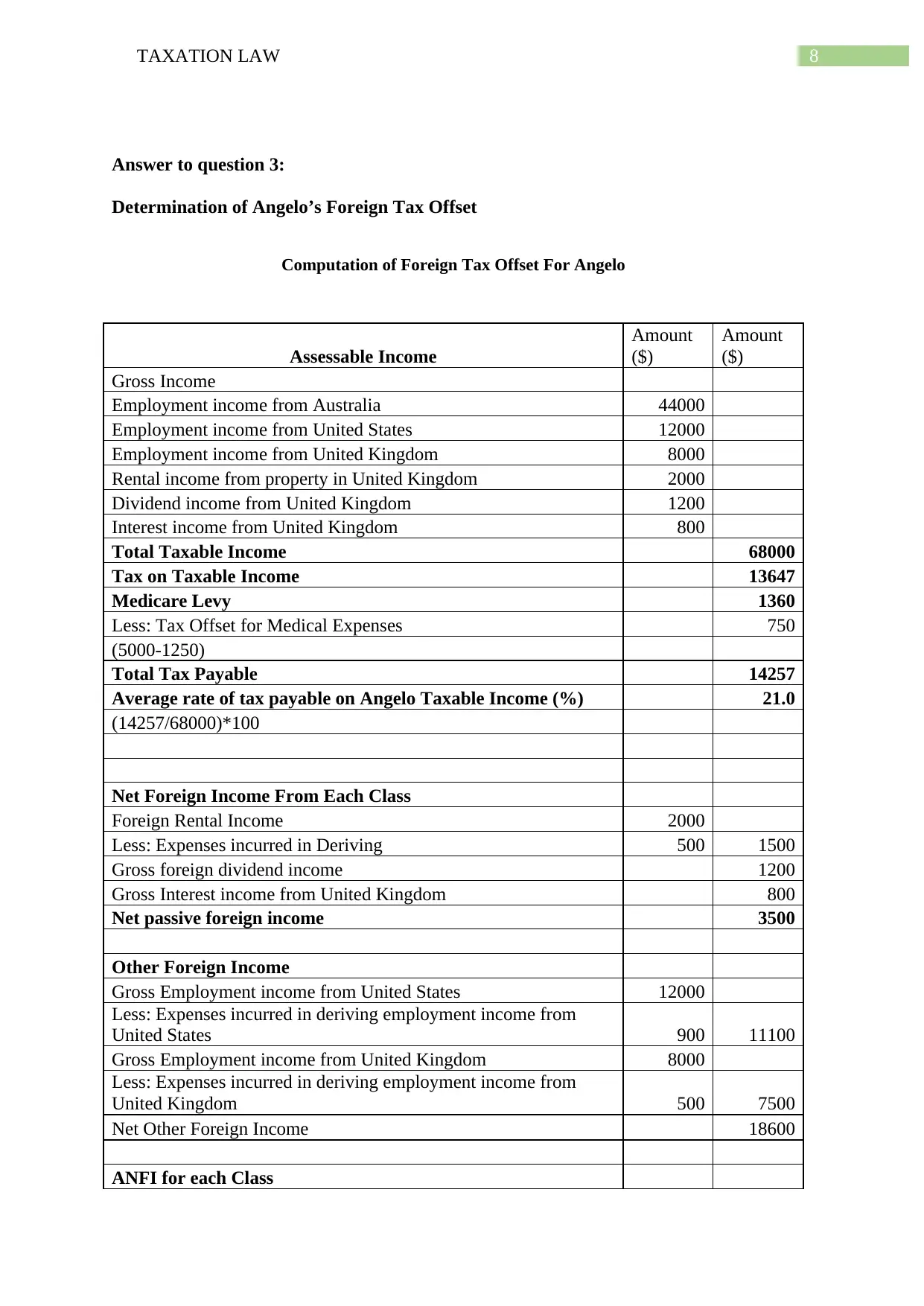
8TAXATION LAW
Answer to question 3:
Determination of Angelo’s Foreign Tax Offset
Computation of Foreign Tax Offset For Angelo
Assessable Income
Amount
($)
Amount
($)
Gross Income
Employment income from Australia 44000
Employment income from United States 12000
Employment income from United Kingdom 8000
Rental income from property in United Kingdom 2000
Dividend income from United Kingdom 1200
Interest income from United Kingdom 800
Total Taxable Income 68000
Tax on Taxable Income 13647
Medicare Levy 1360
Less: Tax Offset for Medical Expenses 750
(5000-1250)
Total Tax Payable 14257
Average rate of tax payable on Angelo Taxable Income (%) 21.0
(14257/68000)*100
Net Foreign Income From Each Class
Foreign Rental Income 2000
Less: Expenses incurred in Deriving 500 1500
Gross foreign dividend income 1200
Gross Interest income from United Kingdom 800
Net passive foreign income 3500
Other Foreign Income
Gross Employment income from United States 12000
Less: Expenses incurred in deriving employment income from
United States 900 11100
Gross Employment income from United Kingdom 8000
Less: Expenses incurred in deriving employment income from
United Kingdom 500 7500
Net Other Foreign Income 18600
ANFI for each Class
Answer to question 3:
Determination of Angelo’s Foreign Tax Offset
Computation of Foreign Tax Offset For Angelo
Assessable Income
Amount
($)
Amount
($)
Gross Income
Employment income from Australia 44000
Employment income from United States 12000
Employment income from United Kingdom 8000
Rental income from property in United Kingdom 2000
Dividend income from United Kingdom 1200
Interest income from United Kingdom 800
Total Taxable Income 68000
Tax on Taxable Income 13647
Medicare Levy 1360
Less: Tax Offset for Medical Expenses 750
(5000-1250)
Total Tax Payable 14257
Average rate of tax payable on Angelo Taxable Income (%) 21.0
(14257/68000)*100
Net Foreign Income From Each Class
Foreign Rental Income 2000
Less: Expenses incurred in Deriving 500 1500
Gross foreign dividend income 1200
Gross Interest income from United Kingdom 800
Net passive foreign income 3500
Other Foreign Income
Gross Employment income from United States 12000
Less: Expenses incurred in deriving employment income from
United States 900 11100
Gross Employment income from United Kingdom 8000
Less: Expenses incurred in deriving employment income from
United Kingdom 500 7500
Net Other Foreign Income 18600
ANFI for each Class
⊘ This is a preview!⊘
Do you want full access?
Subscribe today to unlock all pages.

Trusted by 1+ million students worldwide
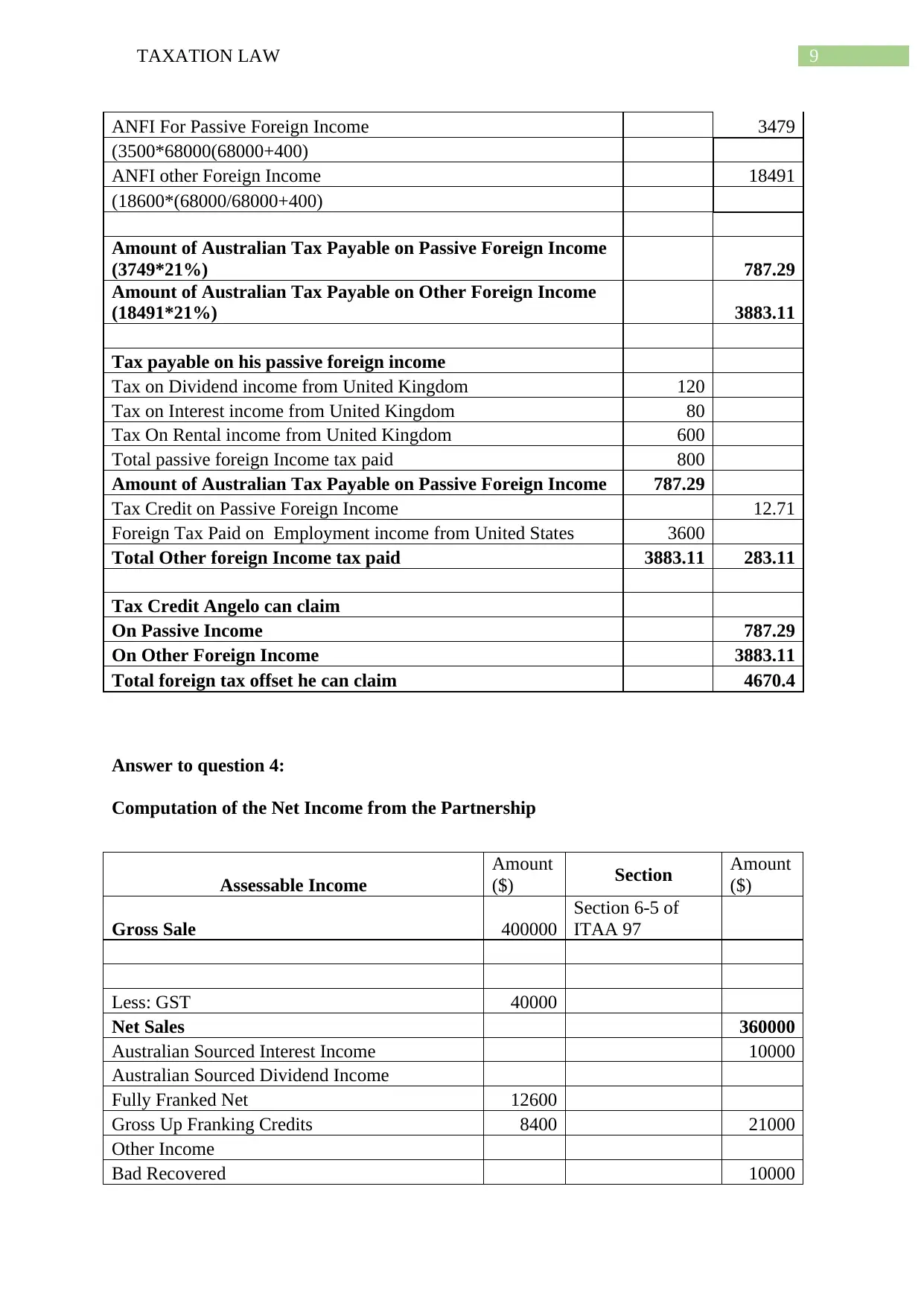
9TAXATION LAW
ANFI For Passive Foreign Income 3479
(3500*68000(68000+400)
ANFI other Foreign Income 18491
(18600*(68000/68000+400)
Amount of Australian Tax Payable on Passive Foreign Income
(3749*21%) 787.29
Amount of Australian Tax Payable on Other Foreign Income
(18491*21%) 3883.11
Tax payable on his passive foreign income
Tax on Dividend income from United Kingdom 120
Tax on Interest income from United Kingdom 80
Tax On Rental income from United Kingdom 600
Total passive foreign Income tax paid 800
Amount of Australian Tax Payable on Passive Foreign Income 787.29
Tax Credit on Passive Foreign Income 12.71
Foreign Tax Paid on Employment income from United States 3600
Total Other foreign Income tax paid 3883.11 283.11
Tax Credit Angelo can claim
On Passive Income 787.29
On Other Foreign Income 3883.11
Total foreign tax offset he can claim 4670.4
Answer to question 4:
Computation of the Net Income from the Partnership
Assessable Income
Amount
($) Section Amount
($)
Gross Sale 400000
Section 6-5 of
ITAA 97
Less: GST 40000
Net Sales 360000
Australian Sourced Interest Income 10000
Australian Sourced Dividend Income
Fully Franked Net 12600
Gross Up Franking Credits 8400 21000
Other Income
Bad Recovered 10000
ANFI For Passive Foreign Income 3479
(3500*68000(68000+400)
ANFI other Foreign Income 18491
(18600*(68000/68000+400)
Amount of Australian Tax Payable on Passive Foreign Income
(3749*21%) 787.29
Amount of Australian Tax Payable on Other Foreign Income
(18491*21%) 3883.11
Tax payable on his passive foreign income
Tax on Dividend income from United Kingdom 120
Tax on Interest income from United Kingdom 80
Tax On Rental income from United Kingdom 600
Total passive foreign Income tax paid 800
Amount of Australian Tax Payable on Passive Foreign Income 787.29
Tax Credit on Passive Foreign Income 12.71
Foreign Tax Paid on Employment income from United States 3600
Total Other foreign Income tax paid 3883.11 283.11
Tax Credit Angelo can claim
On Passive Income 787.29
On Other Foreign Income 3883.11
Total foreign tax offset he can claim 4670.4
Answer to question 4:
Computation of the Net Income from the Partnership
Assessable Income
Amount
($) Section Amount
($)
Gross Sale 400000
Section 6-5 of
ITAA 97
Less: GST 40000
Net Sales 360000
Australian Sourced Interest Income 10000
Australian Sourced Dividend Income
Fully Franked Net 12600
Gross Up Franking Credits 8400 21000
Other Income
Bad Recovered 10000
Paraphrase This Document
Need a fresh take? Get an instant paraphrase of this document with our AI Paraphraser
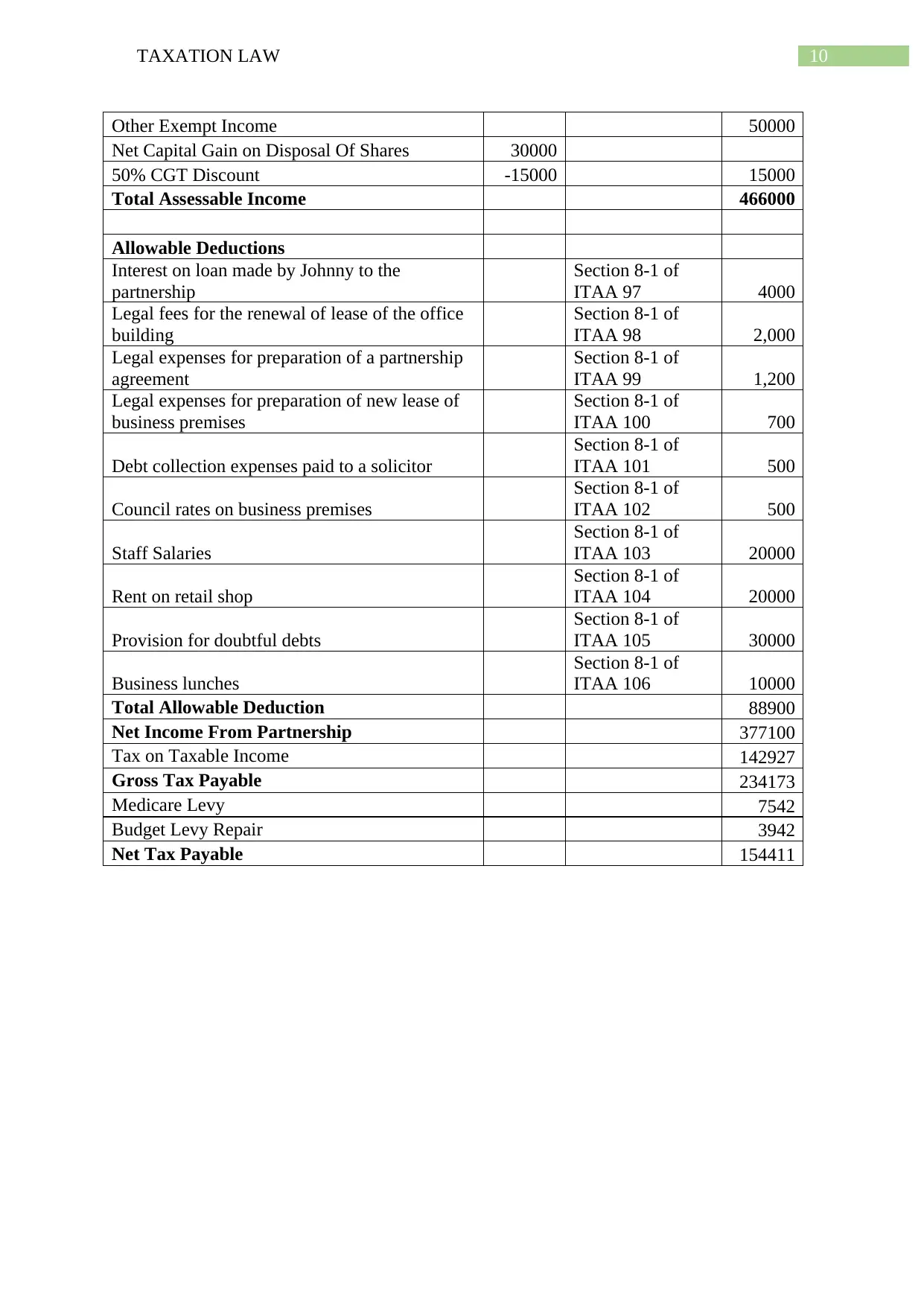
10TAXATION LAW
Other Exempt Income 50000
Net Capital Gain on Disposal Of Shares 30000
50% CGT Discount -15000 15000
Total Assessable Income 466000
Allowable Deductions
Interest on loan made by Johnny to the
partnership
Section 8-1 of
ITAA 97 4000
Legal fees for the renewal of lease of the office
building
Section 8-1 of
ITAA 98 2,000
Legal expenses for preparation of a partnership
agreement
Section 8-1 of
ITAA 99 1,200
Legal expenses for preparation of new lease of
business premises
Section 8-1 of
ITAA 100 700
Debt collection expenses paid to a solicitor
Section 8-1 of
ITAA 101 500
Council rates on business premises
Section 8-1 of
ITAA 102 500
Staff Salaries
Section 8-1 of
ITAA 103 20000
Rent on retail shop
Section 8-1 of
ITAA 104 20000
Provision for doubtful debts
Section 8-1 of
ITAA 105 30000
Business lunches
Section 8-1 of
ITAA 106 10000
Total Allowable Deduction 88900
Net Income From Partnership 377100
Tax on Taxable Income 142927
Gross Tax Payable 234173
Medicare Levy 7542
Budget Levy Repair 3942
Net Tax Payable 154411
Other Exempt Income 50000
Net Capital Gain on Disposal Of Shares 30000
50% CGT Discount -15000 15000
Total Assessable Income 466000
Allowable Deductions
Interest on loan made by Johnny to the
partnership
Section 8-1 of
ITAA 97 4000
Legal fees for the renewal of lease of the office
building
Section 8-1 of
ITAA 98 2,000
Legal expenses for preparation of a partnership
agreement
Section 8-1 of
ITAA 99 1,200
Legal expenses for preparation of new lease of
business premises
Section 8-1 of
ITAA 100 700
Debt collection expenses paid to a solicitor
Section 8-1 of
ITAA 101 500
Council rates on business premises
Section 8-1 of
ITAA 102 500
Staff Salaries
Section 8-1 of
ITAA 103 20000
Rent on retail shop
Section 8-1 of
ITAA 104 20000
Provision for doubtful debts
Section 8-1 of
ITAA 105 30000
Business lunches
Section 8-1 of
ITAA 106 10000
Total Allowable Deduction 88900
Net Income From Partnership 377100
Tax on Taxable Income 142927
Gross Tax Payable 234173
Medicare Levy 7542
Budget Levy Repair 3942
Net Tax Payable 154411
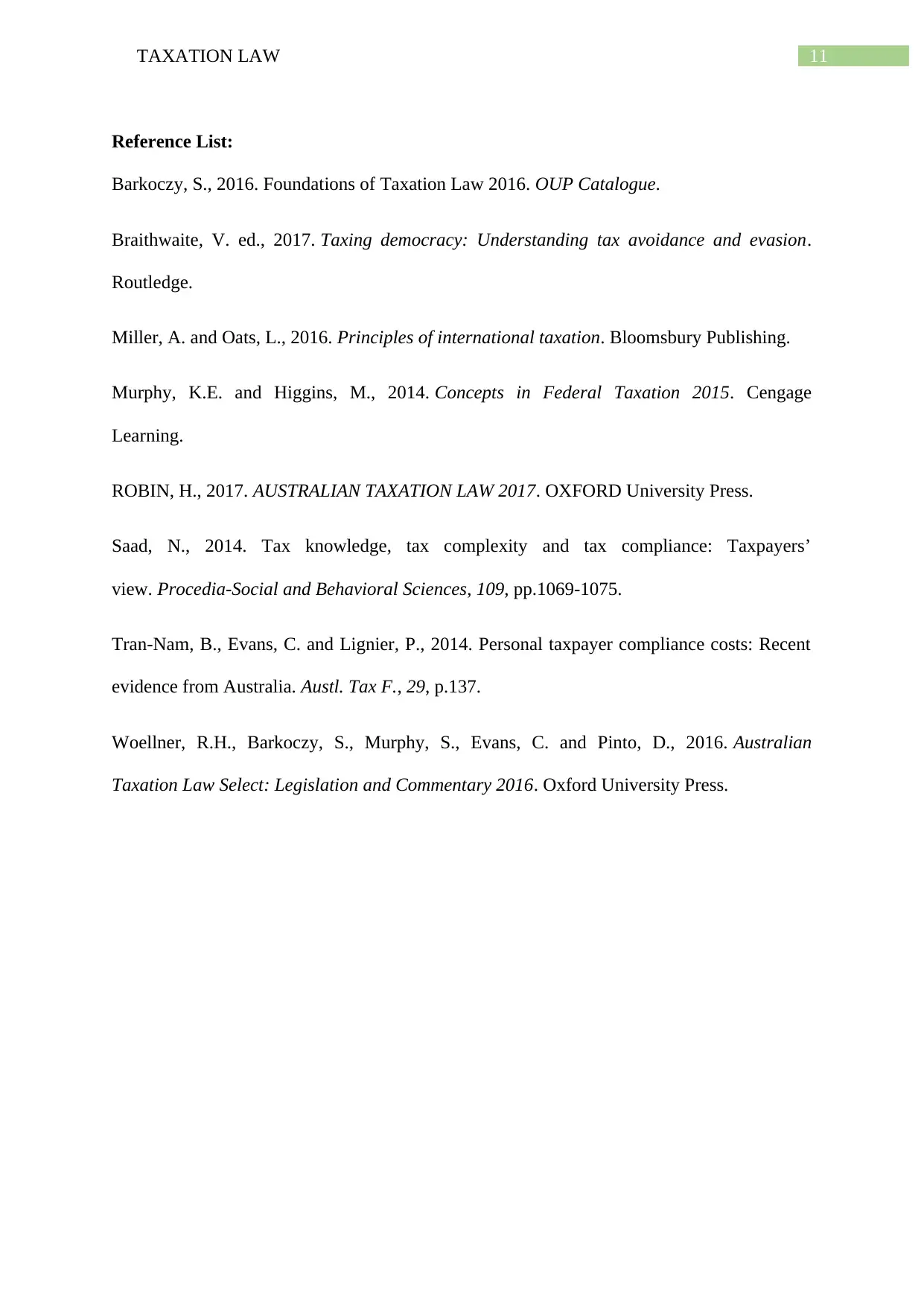
11TAXATION LAW
Reference List:
Barkoczy, S., 2016. Foundations of Taxation Law 2016. OUP Catalogue.
Braithwaite, V. ed., 2017. Taxing democracy: Understanding tax avoidance and evasion.
Routledge.
Miller, A. and Oats, L., 2016. Principles of international taxation. Bloomsbury Publishing.
Murphy, K.E. and Higgins, M., 2014. Concepts in Federal Taxation 2015. Cengage
Learning.
ROBIN, H., 2017. AUSTRALIAN TAXATION LAW 2017. OXFORD University Press.
Saad, N., 2014. Tax knowledge, tax complexity and tax compliance: Taxpayers’
view. Procedia-Social and Behavioral Sciences, 109, pp.1069-1075.
Tran-Nam, B., Evans, C. and Lignier, P., 2014. Personal taxpayer compliance costs: Recent
evidence from Australia. Austl. Tax F., 29, p.137.
Woellner, R.H., Barkoczy, S., Murphy, S., Evans, C. and Pinto, D., 2016. Australian
Taxation Law Select: Legislation and Commentary 2016. Oxford University Press.
Reference List:
Barkoczy, S., 2016. Foundations of Taxation Law 2016. OUP Catalogue.
Braithwaite, V. ed., 2017. Taxing democracy: Understanding tax avoidance and evasion.
Routledge.
Miller, A. and Oats, L., 2016. Principles of international taxation. Bloomsbury Publishing.
Murphy, K.E. and Higgins, M., 2014. Concepts in Federal Taxation 2015. Cengage
Learning.
ROBIN, H., 2017. AUSTRALIAN TAXATION LAW 2017. OXFORD University Press.
Saad, N., 2014. Tax knowledge, tax complexity and tax compliance: Taxpayers’
view. Procedia-Social and Behavioral Sciences, 109, pp.1069-1075.
Tran-Nam, B., Evans, C. and Lignier, P., 2014. Personal taxpayer compliance costs: Recent
evidence from Australia. Austl. Tax F., 29, p.137.
Woellner, R.H., Barkoczy, S., Murphy, S., Evans, C. and Pinto, D., 2016. Australian
Taxation Law Select: Legislation and Commentary 2016. Oxford University Press.
⊘ This is a preview!⊘
Do you want full access?
Subscribe today to unlock all pages.

Trusted by 1+ million students worldwide
1 out of 12
Related Documents
Your All-in-One AI-Powered Toolkit for Academic Success.
+13062052269
info@desklib.com
Available 24*7 on WhatsApp / Email
![[object Object]](/_next/static/media/star-bottom.7253800d.svg)
Unlock your academic potential
Copyright © 2020–2025 A2Z Services. All Rights Reserved. Developed and managed by ZUCOL.





